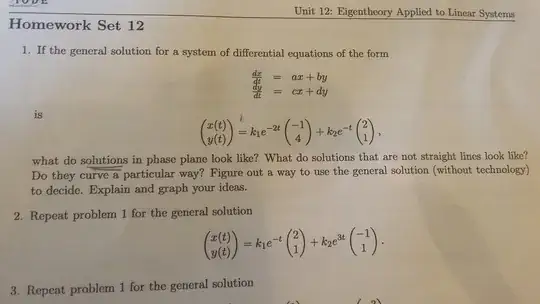I would start by making the substitution $s=e^{-t}$ in the solution to get the parametric equations $$\begin{align} x &= -k_1s^2+2k_2s \\ y &= 4k_1s^2+k_2s. \end{align}$$ This is a parameterization of a parabola, and, as described here, we can read several of its properties directly from this parameterization: its axis is parallel to $[-1,4]^T$ and it passes through the origin with tangent parallel to $[2,1]^T$ there. Not surprisingly, these correspond to the two linear trajectories that you’ve already computed. The “openness” of the parabola and the direction in which it opens is determined by the ratio ${k_2^2\over k_1}$. You can also find the parabola’s vertex by using the condition that its tangent there is orthogonal to its axis.
If you didn’t recognize the parametric equations as that of a parabola, you could produce a Cartesian equation for the curve by eliminating $s$. You can do this by proceeding through a series of rearrangements and back-substitutions, or use the method of resultants illustrated here: a Cartesian equation of the curve is $$\det\begin{bmatrix} -k_1 & 2k_2 &-x & 0 \\ 0 & -k_1 & 2k_2 & -x \\ 4k_1 & k_2 & -y & 0 \\ 0 & 4k_1 & k_2 & -y \end{bmatrix} = k_1(16k_1x^2+8k_1xy+k_1y^2+9k_2^2x-18k_2^2y) = 0,$$ which is some sort of conic section. For $k_1\ne0$ the discriminant of this conic vanishes, so it represents a (possibly degenerate) parabola. (You’ve already found that for $k_1=0$ the trajectory is a line.) The direction of its axis can be found by computing an eigenvector of $0$ of the quadratic part, but in this case the quadratic part is easily factored into $k_1(4x+y)^2$, from which you can see that the axis is perpendicular to $[4,1]^T$, i.e., is parallel to $[-1,4]^T$, just as determined previously. Other attributes of the parabola can also be extracted from the coefficients of the Cartesian equation, but frankly, it’s easier to work directly with the parametric form.
Last, but not least, the exponents in the solution are negative, so the flow along any of the solution curves with increasing $t$ is toward the origin.
